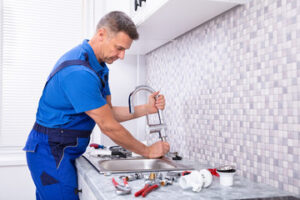Plumbing Installation is the process of installing pipes, fixtures and appliances in new construction and renovation projects. It requires extensive knowledge of plumbing systems and their components.
In this stage, your plumber will map out the layout and placement of plumbing lines. They will also secure and install the system’s skeletal structure, including drain, waste and vent pipes. Contact Warrior Plumbing, LLC for professional help.
Rough-In Phase

If you are constructing a new home or commercial building, it is essential that your plumbing installation meets the highest standards of quality and safety. This includes working with professional plumbers who are familiar with the plumbing construction process and can complete your project in a timely manner. Understanding the three fundamental phases of plumbing construction will help you plan accordingly and ensure that your finished product meets all state and local regulations.
What Is the Rough-In Phase?
During the rough-in phase, plumbing professionals install the basic pipes and infrastructure of your new building. This includes the drain, waste, and vent (DWV) system. It also includes setting the sewer accommodation stubs, which connect your home to the municipal sewerage system.
In this stage, plumbers will also make pipeline connections within walls and other cavities of your building. This is accomplished by drilling holes and running pipe through them, with each end capped or sealed to prevent leaks. Rough-in plumbing typically takes place after the foundation and framing are completed, but before the slab is poured.
The underground rough-in phase is a key component of your home plumbing system, and it’s essential to ensure that it’s done properly. To avoid costly mistakes that could require breaking concrete to fix, your builder or general contractor should work with a professional plumbing company to lay and test all pipework under the ground. This includes laying and testing drain lines, water supply pipes, and gas and flue pipes.
Aboveground Rough-in Plumbing
During this phase, plumbers will begin installing the above-ground components of your plumbing system. This includes preparing and repairing the water service line, connecting it to your house’s main water line, and testing the supply pressure to identify any potential issues. It also involves installing the DWV system, which is composed of vent pipes that connect to your sinks, toilets, and showers to remove wastewater and prevent odors from building up in your home.
Plumbers will also set your toilet flanges, tub and shower drains, and install sink and appliance drains during the above-ground rough-in plumbing phase. This is important because many of these fixtures are too large to set once the walls are framed, and it’s much easier to do this before they have to be secured in place.
Finish Plumbing
Once all of the rough-in plumbing has been installed, your plumber will set your fixture faucets and toilets and connect them to your water supply and drainage systems. This is an important step to ensure that your plumbing system functions properly and can meet all of your expectations for aesthetics and functionality. In this stage, your plumber will also set up your hot water heater and ensure that all of the gas lines have been connected. After this phase, you will be able to enjoy your new plumbing fixtures and can rest assured that your home or business’s plumbing is up to par with all state and local regulations.